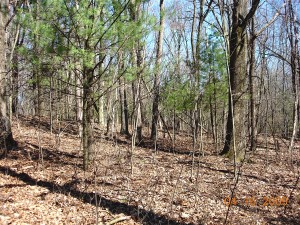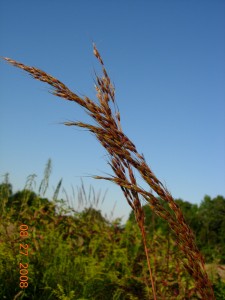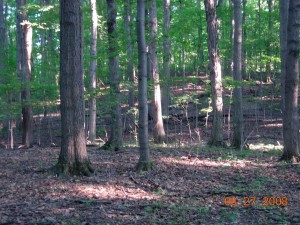
Bur Oak at the Colony Farm Orchard, a protected area threatened by expansion of the WMU Business Park
Following are brief descriptions of the major vegetation types in Oshtemo Township (Kalamazoo County, Michigan) about the time of settlement. This is the second and concluding installment of a talk given at the March 2009 meeting of the Oshtemo Historical Society.
Information is also provided about what settlement, agriculture, and development have done to original plant communities. Some protection and restoration possibilities are mentioned under “Current Status.” Major invasive species are listed. Invasives are plants or animals, usually non-native, that invade and spread, usually at the expense of native species. Control of invasives may be necessary for conservation.
1. Oak Savanna and Oak Forest (together occupied 88% of Township)
These are treated together because they are similar except for crown coverage. Areas where the canopy coverage was more than 50% are termed forest.
Tree species–The widespread oak savannas that the settlers usually termed “openings” were dominated by white oak. Chinkapin (yellow chestnut) oak, bur oak, and hickory (mostly pignut) were present but not common. Black oak was also present but was common only on the driest soils and was often associated with dry sand prairie. Shrubs included flowering dogwood, hazelnut, New Jersey tea, and shadbush.
Herbs–A great variety, depending on the specifics of the site and also its fire history. The species ranged from herbs we would now think of as mesic prairie species to ones that now are mostly in forest, even beech-maple forest.
What happened to it?–Much of it was cut over for timber and charcoal which was used in large quantities by blacksmiths. Large areas were also cleared for agriculture, including orchards. More recently remnants are being lost to residential development. Sites not cut over became brushy and denser owing to invasion of other trees and shrubs in the absence of fire.

Oak forest in Oshtemo Township shows recent invasion by white pine and red maple. Photo copyright 2009 Richard Brewer
Current status–No intact examples are left, but a fair amount of land exists occupied by more or less disturbed remnants. In the past 30 years these have been heavily invaded by red maple and white pine. Both species were almost absent from uplands in 1830. Because of the dense shade these trees cast, less shade-tolerant herbs and shrubs are reduced. To provide a demonstration of what most of the township was originally like, a few sites of considerable acreage should be set aside. Invading maples and pines should be removed and a continuing fire management regime should be started.
Invasives–Tartarian honeysuckle, Common privet, garlic mustard, dame’s rocket, and recently money plant.
2. Other-than-mesic Prairie
These prairie types ranging from wet to dry mostly tended to be associated with oak savanna on sites of appropriate soil moisture and fire history.
For example, on south- and west-facing slopes especially next to lakes or broad valleys occurred hill prairies, also called goat prairies. These shared some species with the adjoining forest or savanna and some with other prairie types; they also had a few distinctive species.
Wet prairie occurred on lowlands associated with wetland herbaceous communities.
Current status–Few if any sites left because of development and absence of fire; any sites that contain a sampling of the characteristic species are worth preservation. Searches should be made of the appropriate slopes for hill prairie remnants and of the few wetlands for wet prairie species.
3. Mesic or Tall-grass Prairie (Grand and Genesee Prairies were 2% of Township)
Tree species–Mesic prairies were treeless. Bur oak might occur at the edge.
Herbs and grasses–Big bluestem and Indian grass were the most important tall grasses, but several other species of lesser stature were present. Important herbs included bird’s foot violet, compass plant and two other species of Silphium, culver’s root, various asters, goldenrods, sunflowers, and legumes.

Indian grass, one of the dominant tall grasses in mesic prairie. Photo copyright 2009 Richard Brewer
What happened to it?–Mesic prairie was the first land settled and nearly all was plowed. The only parcels that escaped were in the earliest cemeteries and perhaps some land along the earliest railroads. However, some remnants of bur oak plains and white oak openings on better soils included plants that also were prominent on mesic prairie. In the past 30 or 40 years, disturbance and lack of fire have reduced or obliterated the few remnants in these categories.
Current status–All sites containing any combination of mesic prairie species are worthy of preservation; however, most sites dominated by mesic prairie species will be the result of restoration.
4. Bur Oak Plains (3% of Township)
This savanna was usually adjacent to mesic prairie. It shared many of the same herbs and grasses and probably originated (and was eliminated) in the same way. No remnants that include bur oaks and characteristic ground layer vegetation are known.
5. Beech-sugar maple Forest (6.5% of Township)
Trees–Beech, sugar maple, basswood, tulip tree, white ash, slippery elm (now nearly gone from Dutch elm disease), red oak, bitternut hickory.

A fall view of beech-sugar maple forest in the Mildred Harris Sanctuary (Audubon Society of Kalamazoo) in Alamo Township. Photo copyright 2009 Richard Brewer
In understory–Blue beech, hophornbeam. Spice bush and red-berried elder are the most important large shrubs; running strawberry bush (genus Euonymus) and gooseberry also occur.
Herbs–A large variety including the spring ephemerals such as spring beauty, toothwort, large-flowered trillium, Dutchman’s breeches. Non-ephemerals and summer-flowering species fewer; examples are nettles, putty-root, water-leafs, wild leek, May-apple, blue cohosh, doll’s-eyes.
What happened to it?–Mostly cut over and converted to agriculture. Beech-maple forest in Oshtemo was the south end of the same patch that extended northeast all the way to Cooper Township, where relict stands persist in Markin Glen Park and the Kalamazoo Nature Center.
Current status–Virtually gone. Elsewhere in Kalamazoo county, a few remnants were preserved by land owners because of their beauty and the spring flowers; some of these have been permanently protected. If any patch of even five or ten acres still existed in Oshtemo Township, it should be conserved. In many preserved sites, the invasive garlic mustard is a serious threat to the herb layer.
6. Wetlands (0.5 present of township)
Small amounts of swamp forest and marsh were evident from the original land survey. A few kettles with perched water tables held buttonbush swamps. As far as now known, no bog, tamarack forest, fen, or other specialized types of wetlands occurred. Likewise, no floodplain forest was present.
Current status–If any of the seemingly absent types such as fen, bog, or wet prairie were found in the township, the sites would be worth conserving. Perhaps the small wedge of swamp forest in the northwest corner should be considered for protection.
[Added 15 November 2009. Over the past week or two I noticed a tamarack tree in the wetland at the west edge of the Lilian Anderson Arboretum not far south of West Main (M-43) in Section 15. In the fall, tamarack needles turn a gold color, so a tamarack is easily noticed at this time. I finally stopped by yesterday, by which time many of the leaves had fallen and the few remaining ones were dull brown. The situation where the tamarack is growing is consistent with the possibility of fen, though I have not noticed fen species at other places along the edge of the wetland on many other trips to the Arboretum. The site is at the base of a slope where ground water feeds a sizable wetland northeast of Bonnie Castle Lake. There are more wetlands across M-43 to the north. I tried to walk around in the vicinity of the tamarack without sinking too deep, and I didn’t see any obvious fen indicator species. But it’s not a good time of year. I’ll have another look or two next spring and summer.]
Conservation Overview
Little natural land is currently preserved in Oshtemo Township. The two township parks are mostly devoted to active recreation. A few years ago the Township lost an opportunity to create a contiguous protected area of at least 200 acres when it voted to convert most of the larger park (Oshtemo Township Park on West Main Street behind the township hall and the library) into an 18-hole disc golf course. A color map available at the township website gives a clear picture of how much of the park was removed from natural processes and devoted to disc golf.
Adjoining the Oshtemo Township disk golf park on the west is more than 130 acres of conserved land owned by Kalamazoo College. The Kalamazoo College land has been dedicated as the Lillian Anderson Arboretum; however, only about 30 acres of the land is, in fact, permanently protected (by a conservation easement held by the Southwest Michigan Land Conservancy).
Another protected tract is a short segment of the Kal-Haven Trail (owned by the state of Michigan) cutting across the northeast corner of the township. Adjoining this section of the Kal-Haven Trail is about 100 acres owned by the Kalamazoo Nature Center as the result of a bequest from Mildred Harris.
A part of Western Michigan University’s Asylum Lake property lies in Oshtemo Township between Drake Road and U.S.-131 . It is, to a degree, protected since it was conveyed to WMU by the state to be used “solely for public park, recreation or other open-space purposes unless otherwise authorized by public act.” Part of the 55-acre site was used as an orchard by the Kalamazoo State Hospital’s Colony Farm from the 1880s into the 1950s. The now-abandoned orchard supports a number of forest and thicket bird species. The land is also of historical and archaeological interest because of its use in the farm operations of the state hospital and also because of its location within the savanna complex immediately surrounding Genesee Prairie. See the next (earlier) post for a current threat to the continued existence of this protected land.
Few other protected sites exist. Most of the land holdings in the township are small parcels of 40 acres or less. Consequently, establishment of preserves large enough to be suitable habitat for birds and larger mammals will in most cases require acquisition (or protection by conservation easement) of two to several parcels.
Pingback: Conservation Values of the Colony Farm Orchard, Kalamazoo County, Michigan | Richard Brewer